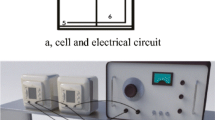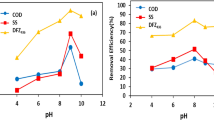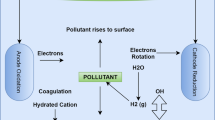Abstract
In this study, the treatability of marble processing wastewater by electrocoagulation using aluminum and iron electrodes was investigated. The sample used was from the marble-processing plant in Sivas and its turbidity, suspended solids, chemical oxygen demand and total solids concentrations were about 1,914 NTU, 2,904, 150 and 4,750 mg/L, respectively. The effects of various operating parameters such as initial pH, current density and electrolysis time on turbidity, suspended solids, chemical oxygen demand and total solids removal efficiencies were investigated. The settling characteristics of waste sludge produced and energy and electrode consumption were also determined. The optimum values of initial pH, current density and electrolysis time in electrocoagulation studies carried out using aluminum electrode were found to be 7.8, 30 A/m2 and 5 min, respectively. Under these conditions, the removal efficiencies obtained for turbidity, suspended solids, chemical oxygen demand and total solids were 98.5, 99.2, 55.2 and 92.4 %, respectively. Corresponding energy and electrode consumptions were 0.143 kWh/kg SS and 0.010 kg Al/kg SS. For iron electrode, the optimum parameter values were found to be 7.8 pH, 20 A/m2 and 5 min, respectively. Under these conditions, removal efficiencies for turbidity, suspended solids, chemical oxygen demand and total solids were determined as 94.3, 99.1, 54.2, and 96.1 %, respectively. Energy and electrode consumptions were 0.0571 kWh/kg SS and 0.0206 kg Fe/kg SS, respectively. Settling characteristics of sludge produced during experiments carried out using both aluminum and iron electrodes were fairly good. The results showed that electrocoagulation method can be used efficiently for the treatment of marble processing wastewater under proper operating conditions.












Similar content being viewed by others

References
Acar H (2001) Mermer işleme tesisi için atıksu arıtma sistemi kurulması ve işletilmesinde dikkat edilmesi gerekli hususlar. Türkiye III. Mermer Sempozyumu. Afyon, pp 289–296
American Public Health Association (APHA) (1992) Standard methods for examination of water and wastewater, 17th edn. American Public Health Association, American Water Works Associations, Water Environment Federation, Washington DC, USA
Aoudj S, Khelifa A, Drouiche N, Necini M, Hamitouche H (2010) Electrocoagulation process applied to wastewater containing dyes from textile industry. Chem Eng Process 49:1176–1182
Arslan EI, Aslan S, Ipek U, Altun S, Yazıcıoglu S (2005) Physico-chemical treatment of marble processing wastewater and the recycling of its sludge. Waste Manage Res 23:550–559
Atmaca E (2009) Treatment of landfill leachate by using electro-Fenton method. J Hazard Mater 163:109–114
Ayoub GM, Merhebi F, Acra A, El-Fadel M, Kopman B (2000) Seawater bittern for the treatment of alkalized industrial effluents. Water Res 34(2):640–656
Bayramoglu M, Kobya M, Can OT, Sozbir M (2004) Operating cost analysis of electrocoagulation of textile dye wastewater. Sep Purif Technol 37:117–125
Bukhari AA (2008) Investigation of the electrocoagulation treatment process for the removal of total suspended solids and turbidity from municipal wastewater. Bioresource Technol 99(40):914–921
Chen X, Chen G, Yue PL (2000) Separation of pollutans from restaurant wastewater by electrocoagulation. Sep Purif Technol 19(1–2):65–76
Daneshvar N, Ashassi-Sorkhabi H, Kasiri MB (2004) Decolorization of dye solution containing Acid Red 14 by electrocoagulation with a comparative investigation of different electrode connections. J Hazard Mater B 112:55–62
Daneshvar N, Khatae AR, Djafarzadeh N (2006) The use artifical neural networks (ANN) for modeling of decolorization of textile dye solution containing C.I. Basic Yellow 28 by electrocoagulation process. J Hazard Mater 137:1788–1795
Daneshvar N, Khatae AR, Amani Ghadim AR, Rasoulifard MH (2007) Decolorization of C.I. Acid Yellow 23 solution by electrocoagulation process. Investigation of operational parameters and evaluation of specific electrical energy consumption (SEEC). J Hazard Mater 148:566–572
Donini JC, Kan J, Szynkarczuk J, Hassan TA, Kar KL (1994) Operating Cost of Electrocoagulation. Can J Chem Eng 72:1007–1012
Ersoy B (2003) Mermer işleme tesisi atıksu arıtımında kullanılan flokların tanıtımı. Türkiye IV. Mermer Sempozyum. Afyon, pp 449–462
Gomes JAG, Cocke DL, Daida P, Kesmez M, Weir M, Moreno H, Parga JR, Irwin G, McWhinney H, Grady T, Peterson E (2007) Arsenic removal by electrocoagulation using combined Al–Fe electrode system and characterization of products. J Hazard Mater 139:220–231
Holt PK, Barton GW, Wark M, Mitchell CA (2002) A quantitative comparison between chemical dosing and electrocoagulation. Colloids Surf A 211:233–248
Jin-wei F, Ya-bing S, Zheng Z, Ji-biao Z, Yuan-chun T (2007) Treatment of tannery wastewater by electrocoagulation. J Environ Sci 19:1409–1415
Kashefialasl M, Khosravi M, Marandi R, Seyyedi K (2006) Treatment of dye solution containing colored index acid yellow 36 by electrocoagulation using iron electrodes. Int J Environ Sci Technol 2(4):365–371
Kobya M, Can OT, Bayramoglu M (2003) Treatment of textile wastewaters by electrocoagulation using iron and aluminum electrodes. J Hazard Mater B 100:163–178
Kobya M, Demirbas E, Can OT, Bayramoglu M (2006a) Treatment of levafix orange textile dye solution by electrocoagulation. J Hazard Mater B 132:183–188
Kobya M, Hiz H, Senturk E, Aydiner C, Demirbas E (2006b) Treatment of potato chips manufacturing wastewater by electrocoagulation. Desalination 190:201–211
Kobya M, Ciftci C, Bayramoglu M, Sensoy MT (2008) Study on the treatment of waste metal cutting fluids using electrocoagulation. Sep Purif Technol 60(3):285–291
Koparal AS, Ogutveren UB (2002) Removal of nitrate from water by electroreduction and electrocoagulation. J. Hazardous Mater 89:83–94
Kumar PR, Chaudhari SC, Khilar KC, Mahajan SP (2004) Removal of arsenic from water by electrocoagulation. Chemosphere 55(9):1245–1252
Mahesh S, Prasad B, Mall ID, Mishra IM (2006) Electrochemical degradation of pulp and paper mill wastewater. Part 1. COD and color removal. Ind Eng Chem Res 45(8):2830–2839
Malakootian M, Yousefi N, Fatehizadeh A (2011) Survey efficiency of electrocoagulation on nitrate removal from aqueous solution. Int J Environ Sci Technol 8(1):107–114
Mameri N, Lounici H, Belhocine D, Grib H, Piron DL, Yahiat Y (2001) Defluoridation of Shara water by small plant electrocoagulation using bipolar aluminum electrodes. Sep Purif Technol 24(1–2):113–119
Mollah MYA, Schennach R, Parga JP, Cocke DL (2001) Electrocoagulation (EC)—science and applications. J Hazard Mater 84(1):29–41
Mollah MYA, Pathak SR, Patil PK, Vayuvegula M, Agrawal TS, Gomes JAG, Kesmez M, Cocke DL (2004) Treatment of orange II azo-dye by electrocoagulation (EC) technique in a continuous flow cell using sacrificial iron electrodes. J Hazard Mater 109(1–3):165–171
Mordirshahla N, Behnajady MA, Mohammadi-Aghdam S (2008) Investigation of the effect of different electrodes and their connections on the removal efficiency of 4-nitrophenol from aqueous solution by electrocoagulation. J Hazard Mater 154(1–3):778–786
Murugananthan M, Raju GB, Prabhakar S (2004) Separation of pollutants from tannery effluents by electro flotation. Sep Purif Technol 40(1):69–75
Ozyonar F (2007) Entegre Et ve Et Ürünleri Tesisleri Atiksularinin Kimyasal Koagülasyon ve Elektrokoagülasyon Yöntemleriyle Aritilabilirliğinin İncelenmesi. Masterthesis, Cumhuriyet University Institute of Natural and Applied Sciences, Sivas
Solak M, Kılıç M, Yazıcı H (2009) Removal of suspended solids and turbidity from marble processing wastewaters by electrocoagulation. Comparison of electrode materials and electrode connection systems. J Hazard Mater 172(1):345–352
Tchobanoglous G, Burton FL, Stensel HD (2003) wastewater engineering. In: Treatment and reuse, 4th ed. Metcalf and Eddy Inc., New York
Un UT, Koparal AS, Ogutveren UB (2009) Electrocoagulation of vegetable oil refinery wastewater using aluminum electrodes. J Environ Manage 90:428–433
Acknowledgments
The authors thank the financial support of Department of Environmental Engineering, Cumhuriyet University, Sivas, Turkey.
Author information
Authors and Affiliations
Corresponding author
Rights and permissions
About this article
Cite this article
Ozyonar, F., Karagozoglu, B. Systematic assessment of electrocoagulation for the treatment of marble processing wastewater. Int. J. Environ. Sci. Technol. 9, 637–646 (2012). https://doi.org/10.1007/s13762-012-0093-z
Received:
Revised:
Accepted:
Published:
Issue Date:
DOI: https://doi.org/10.1007/s13762-012-0093-z



